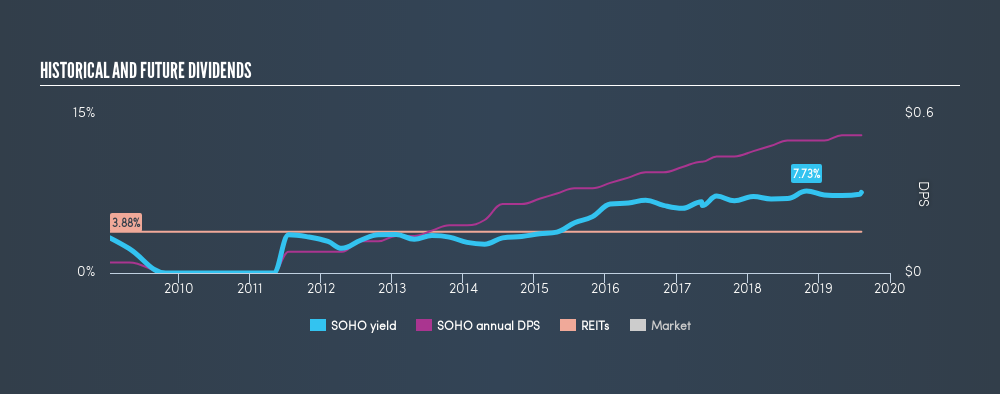- United States
- /
- Hotel and Resort REITs
- /
- NasdaqGM:SOHO
Is Sotherly Hotels Inc. (NASDAQ:SOHO) An Attractive Dividend Stock?

Is Sotherly Hotels Inc. (NASDAQ:SOHO) a good dividend stock? How can we tell? Dividend paying companies with growing earnings can be highly rewarding in the long term. Yet sometimes, investors buy a stock for its dividend and lose money because the share price falls by more than they earned in dividend payments.
In this case, Sotherly Hotels likely looks attractive to investors, given its 7.6% dividend yield and a payment history of over ten years. We'd guess that plenty of investors have purchased it for the income. Some simple research can reduce the risk of buying Sotherly Hotels for its dividend - read on to learn more.
Explore this interactive chart for our latest analysis on Sotherly Hotels!

Payout ratios
Dividends are usually paid out of company earnings. If a company is paying more than it earns, then the dividend might become unsustainable - hardly an ideal situation. As a result, we should always investigate whether a company can afford its dividend, measured as a percentage of a company's net income after tax. Although Sotherly Hotels pays a dividend, it was loss-making during the past year. It's paying out most of its earnings, which limits the amount that can be reinvested in the business. This may indicate limited need for further capital within the business, or highlight a commitment to paying a dividend.
Sotherly Hotels paid out 51% of its cash flow as dividends last year, which is within a reasonable range for the average corporation.
REITs like Sotherly Hotels often have different rules governing their distributions, so a higher payout ratio on its own is not unusual.
Is Sotherly Hotels's Balance Sheet Risky?
As Sotherly Hotels has a meaningful amount of debt, we need to check its balance sheet to see if the company might have debt risks. A rough way to check this is with these two simple ratios: a) net debt divided by EBITDA (earnings before interest, tax, depreciation and amortisation), and b) net interest cover. Net debt to EBITDA measures total debt load relative to company earnings (lower = less debt), while net interest cover measures the ability to pay interest on the debt (higher = greater ability to pay interest costs). Sotherly Hotels has net debt of 8.57 times its EBITDA, which implies meaningful risk if interest rates rise of earnings decline.
Net interest cover can be calculated by dividing earnings before interest and tax (EBIT) by the company's net interest expense. With EBIT of less than 1 times its interest expense, Sotherly Hotels's financial situation is potentially quite concerning. Readers should investigate whether it might be at risk of breaching the minimum requirements on its loans. Low interest cover and high debt can create problems right when the investor least needs them, and we're reluctant to rely on the dividend of companies with these traits.
Dividend Volatility
From the perspective of an income investor who wants to earn dividends for many years, there is not much point buying a stock if its dividend is regularly cut or is not reliable. Sotherly Hotels has been paying dividends for a long time, but for the purpose of this analysis, we only examine the past 10 years of payments. The dividend has been cut by more than 20% on at least one occasion historically. During the past ten-year period, the first annual payment was US$0.04 in 2009, compared to US$0.52 last year. This works out to be a compound annual growth rate (CAGR) of approximately 29% a year over that time. The growth in dividends has not been linear, but the CAGR is a decent approximation of the rate of change over this time frame.
Sotherly Hotels has grown distributions at a rapid rate despite cutting the dividend at least once in the past. Companies that cut once often cut again, but it might be worth considering if the business has turned a corner.
Dividend Growth Potential
With a relatively unstable dividend, it's even more important to see if earnings per share (EPS) are growing. Why take the risk of a dividend getting cut, unless there's a good chance of bigger dividends in future? Over the past five years, it looks as though Sotherly Hotels's EPS have declined at around 55% a year. A sharp decline in earnings per share is not great from from a dividend perspective, as even conservative payout ratios can come under pressure if earnings fall far enough.
Conclusion
Dividend investors should always want to know if a) a company's dividends are affordable, b) if there is a track record of consistent payments, and c) if the dividend is capable of growing. First, we think Sotherly Hotels is paying out an acceptable percentage of its cashflow and profit. Unfortunately, the company has not been able to generate earnings per share growth, and cut its dividend at least once in the past. With this information in mind, we think Sotherly Hotels may not be an ideal dividend stock.
Now, if you want to look closer, it would be worth checking out our free research on Sotherly Hotels management tenure, salary, and performance.
We have also put together a list of global stocks with a market capitalisation above $1bn and yielding more 3%.
We aim to bring you long-term focused research analysis driven by fundamental data. Note that our analysis may not factor in the latest price-sensitive company announcements or qualitative material.
If you spot an error that warrants correction, please contact the editor at editorial-team@simplywallst.com. This article by Simply Wall St is general in nature. It does not constitute a recommendation to buy or sell any stock, and does not take account of your objectives, or your financial situation. Simply Wall St has no position in the stocks mentioned. Thank you for reading.
About NasdaqGM:SOHO
Sotherly Hotels
A self-managed and self-administered lodging REIT focused on the acquisition, renovation, upbranding and repositioning of upscale to upper-upscale full-service hotels in the Southern United States.
Undervalued low.
Similar Companies
Market Insights
Community Narratives





